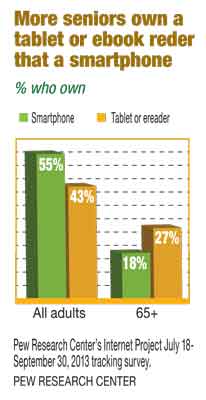 People hate change.
People hate change.
Seniors for the most art have been slow to adopt technology. Research has proven time and again that we all dislike change unless we instigated it. It began with changing classes, changing schools form elementary to high school, fear of the unknown and feeling foolish tempers our behavior.
According to a recent report from Pew Research Center, though seniors are slow to adopt technology compared to younger adults the number of seniors using smartphones and tablets is growing.
The results indicated there are two groups of older users. The first group is more educated, more affluent and younger seniors with a positive attitude about technology and own technology. The second group is older, less affluent; many have health or disability challenges and have little or no exposure to the digital world, websites, PPC or emailing marketing.
Six in Ten Seniors Now Go Online
2012 was the first year where more than half people 65 and older used the Internet. Pew Research recorded that 59% of seniors reported that they go online and 47% of those seniors have high-speed connection at home. The Internet has become the source of consumer information that used to be provided by the yellow pages and newspapers.
41% of seniors do not use the Internet at all and 23% don't have cell phones. Broadband and Internet use drops significantly for seniors 75 and older. Could the slow inclusion of technology be attributed to a satisfaction with lifestyle? Consider the traits of seniors who use the Internet and smartphones.
- 87% of seniors with a college degree go online
- Seniors with an annual household income of $75,000 or more, 90% go online and 82% have broadband at home
Many seniors remain skeptical about the benefits of technology.
 Not all seniors agree that people need the Internet. 35% don't feel that they are missing out on information. For those seniors who adopt technology, digital technology becomes a part f their daily lives. There usually is a strong emotional reason for making that change such as skyping with grandchildren who are too far away to see weekly. For those with a driving need such as this they overcome the challenges with the help of younger family members of friends. Senior use of smartphones still lags far behind at only 18% of seniors using technology. In contrast, 27% of seniors own a tablet, eBook reader of both.
Not all seniors agree that people need the Internet. 35% don't feel that they are missing out on information. For those seniors who adopt technology, digital technology becomes a part f their daily lives. There usually is a strong emotional reason for making that change such as skyping with grandchildren who are too far away to see weekly. For those with a driving need such as this they overcome the challenges with the help of younger family members of friends. Senior use of smartphones still lags far behind at only 18% of seniors using technology. In contrast, 27% of seniors own a tablet, eBook reader of both.
What does this mean short-term?
Businesses who sell to seniors need to have a multi-channel marketing plan incorporating traditional advertising of print, TV and radio ads and direct mail along with digital marketing.
What does it mean long-term?
As the baby-boomers age the number of users will continue to grow. As the 50 something’s become seniors internet marketing strategies need to adapt to their patterns of use. The technology revolution will continue through the next decade. Smart marketing to seniors will be changing as frequently as Google has been changing their algorithms.
Read More: 7 Ways Direct Mail Is Needed in Your Marketing Plan

